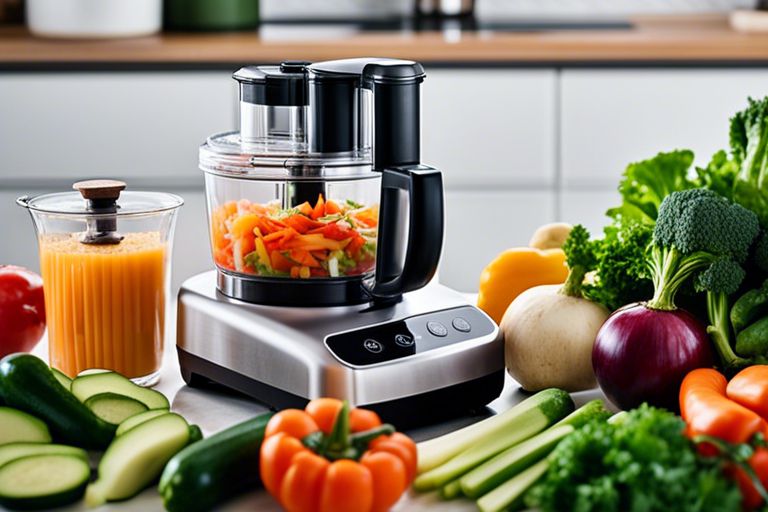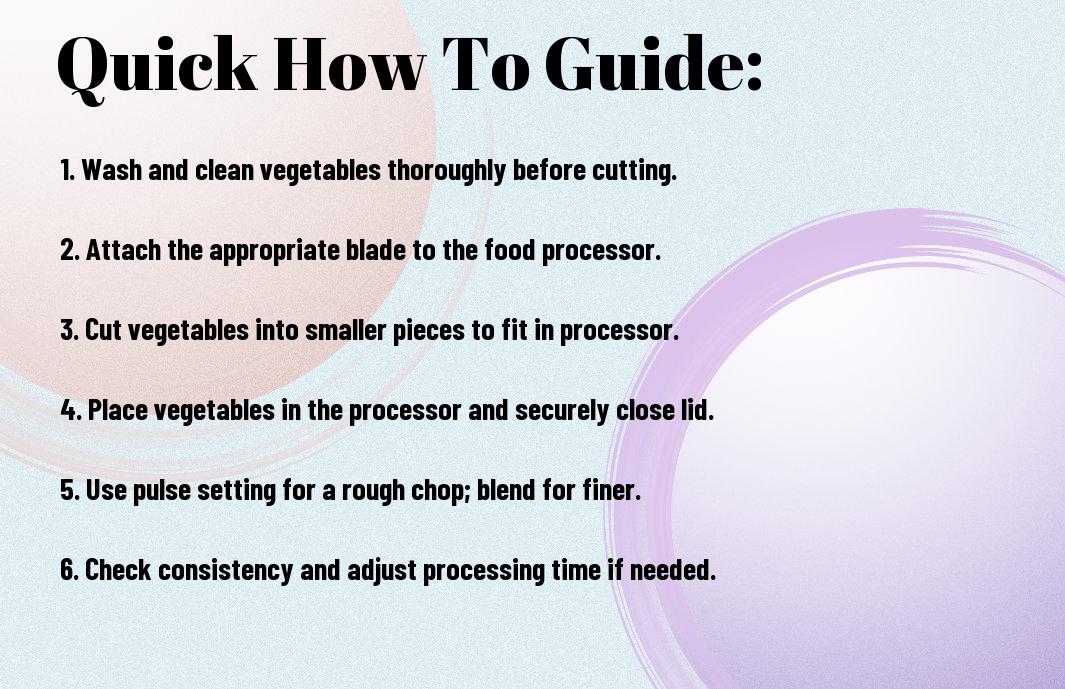There’s no need to spend hours chopping vegetables by hand when you have a handy food processor at your disposal. In this guide, you will learn the step-by-step process of using a food processor to effortlessly and quickly cut a variety of vegetables for your dishes. Say goodbye to tedious chopping and hello to efficient meal prep!

Key Takeaways:
- Versatility: A food processor is a versatile kitchen tool that can efficiently cut a variety of vegetables with different shapes and sizes.
- Time-saving: Using a food processor to cut vegetables can significantly reduce prep time, allowing you to quickly and easily prepare ingredients for your meals.
- Consistency: Food processors ensure uniform cuts for vegetables, resulting in even cooking and a professional-looking presentation for your dishes.

Choosing the Right Food Processor for Cutting Vegetables
Before exploring into using a food processor to cut vegetables, it’s important to choose the right tool for the job. Factors like size, power, and attachments can make a big difference in the efficiency and effectiveness of your food preparation process.
Factors to Consider When Selecting a Food Processor
- Capacity: Consider the amount of vegetables you typically need to cut and choose a food processor with a bowl size that can accommodate that volume.
- Power: Look for a food processor with a powerful motor to effortlessly cut through tough vegetables like potatoes and butternut squash.
- Attachments: Check for specific slicing and shredding blades that will help you achieve the desired cutting results for your recipes.
Any additional features like pulse control, multiple speed options, and dishwasher-safe parts can also enhance the usability and convenience of the food processor for vegetable cutting tasks.
Top Brands and Models for Vegetable Cutting
Now, when it comes to selecting the best food processor for cutting vegetables, you’ll want to consider reputable brands like Cuisinart, KitchenAid, and Breville. These brands offer models with a range of features and capacities to suit different needs and preferences.
Choosing a food processor from a top brand can provide you with the assurance of quality, durability, and performance. Look for models that come with versatile attachments for slicing, shredding, and dicing vegetables to make your food preparation tasks easier and more efficient.
Understanding the key factors and top brands in selecting a food processor for cutting vegetables can help you make an informed decision and invest in a kitchen appliance that will truly enhance your cooking experience.
Preparing Your Vegetables for Processing
Washing and Drying Vegetables for Optimal Results
Now, before you start cutting your vegetables in the food processor, it’s vital to wash them thoroughly to remove any dirt or residue. This step is crucial for both food safety and to ensure that your vegetables are clean before processing.
Little moisture on the vegetables can affect the texture and consistency of the final cut. After washing, make sure to dry the vegetables completely using a clean kitchen towel or paper towels. This will help the blades of the food processor to work efficiently and give you perfectly cut vegetables.
Removing Seeds, Stems, and Leaves for Efficient Cutting
For best results when cutting vegetables in a food processor, it’s vital to remove seeds, stems, and large leaves before processing. This will not only help the food processor work more efficiently but also prevent any unwanted bits from ending up in your dishes.
For vegetables like bell peppers, cucumbers, and tomatoes, make sure to deseed and remove the stems before cutting them in the food processor. Similarly, for leafy greens like kale or spinach, remove the tough stems and any wilted leaves to ensure a smoother cutting process.
Optimal
Optimal prep work before using a food processor will result in evenly cut vegetables and save you time during the cooking process. Taking the time to properly wash, dry, and prep your vegetables will ensure that your food processor can work efficiently and deliver the best results.
Understanding Food Processor Blades and Discs
Keep in mind that your food processor is equipped with different blades and discs that serve various purposes in cutting vegetables. Understanding the function of each blade and disc is important to achieve the desired vegetable cuts for your recipes.
Types of Blades and Discs for Different Vegetable Cuts
- Chopping Blade: Ideal for cutting vegetables into small, evenly sized pieces for dishes like salsa or stir-fries.
- Slicing Disc: Perfect for creating thin or thick slices of vegetables for salads or gratins.
- Julienne Disc: Used to make matchstick-shaped cuts of vegetables, great for stir-fries or garnishes.
- Shredding Disc: Ideal for shredding vegetables like carrots or cabbage for coleslaw or salads.
- Grating Disc: Perfect for grating vegetables like cheese or potatoes for recipes like hash browns or casseroles.
Any additional discs or blades that come with your food processor can offer even more versatility in cutting vegetables for your cooking needs.
How to Choose the Right Blade or Disc for Your Needs
Needs may vary depending on the type of cuts you want for your vegetables. This decision is crucial as the right blade or disc can make a significant difference in the outcome of your dishes. Consider the final presentation and texture you desire when choosing the appropriate blade or disc for your food processor.
This ensures that you achieve the desired results and efficiency in preparing your vegetables. Experimenting with different blades and discs will give you a better understanding of what works best for your specific recipes and preferences.
Basic Cutting Techniques for Vegetables
Many home cooks find chopping vegetables to be a time-consuming and tedious task. However, with a food processor, you can quickly and easily cut various vegetables in a matter of minutes. By mastering basic cutting techniques, you can achieve uniform sizes and shapes for your vegetables, ensuring even cooking and professional-looking results.
Slicing and Julienne Cutting for Uniform Results
Slicing vegetables using a food processor involves cutting them into thin, uniform pieces. This technique is ideal for creating ingredients for salads, stir-fries, or gratins. Julienne cutting, on the other hand, produces thin matchstick-like strips that are perfect for dishes like coleslaw or stir-fried vegetables. By using the slicing and julienne discs provided with your food processor, you can achieve consistent results quickly and efficiently.
Dicing and Mincing for Perfect Texture
Clearly, dicing and mincing are techniques that involve cutting vegetables into small, uniform pieces. Dicing creates cube-shaped vegetables that are great for stews, soups, and casseroles, while mincing produces finely chopped ingredients that can be used in sauces, salsas, or marinades. Food processors come with specific attachments for dicing and mincing, making it easy to achieve the desired texture for your dishes.
Advanced Cutting Techniques for Vegetables
- Shredding and Grating for Creative Recipes
- Pureeing and Chopping for Smooth Textures
Shredding and Grating for Creative Recipes
To achieve different textures and enhance the presentation of your dishes, consider using your food processor for shredding and grating vegetables. This technique is particularly useful for creating slaws, salads, and even incorporating vegetables into baked goods. By experimenting with the size of the shredding or grating disc, you can achieve varying levels of fineness to suit your recipe.
Pureeing and Chopping for Smooth Textures
When you are looking to create silky smooth soups, sauces, or dips, pureeing and chopping vegetables in a food processor is the way to go. By pulsing the vegetables until they reach the desired consistency, you can easily control the texture of your end product. This technique is also perfect for making homemade baby food or incorporating vegetables into meatloaf or burger patties.
Vegetables: To ensure even chopping or pureeing, it’s important to cut your vegetables into uniform pieces before adding them to the food processor. This will help achieve a consistent texture and avoid overprocessing some pieces while leaving others chunky.
Tips for Efficient and Safe Food Processing
All food processors come with safety features, but it’s important to follow some tips for efficient and safe food processing. Here are some guidelines to ensure your cutting and chopping tasks are done properly:
How to Prevent Overloading and Clogging
- The key to preventing overloading and clogging is to work in batches. Make sure not to exceed the recommended maximum capacity of your food processor.
- It’s also important to cut vegetables into smaller, uniform pieces before processing them to prevent clogging and ensure even chopping.
Knowing how much your food processor can handle will not only prevent damage to the machine but also allow for more efficient and consistent results.
Safety Precautions for Handling Sharp Blades and Hot Machines
- When handling sharp blades, always use caution and follow the manufacturer’s instructions for assembly and disassembly.
- Be sure to unplug the food processor and let it cool down before cleaning or removing the blades to prevent accidental cuts or burns.
Handling sharp blades and hot machines requires attention to detail and diligence to prevent any potential injuries. Always keep the safety of yourself and others in mind when using a food processor.
Efficient and safe food processing not only ensures that your vegetables are cut precisely and evenly, but also keeps you and your kitchen safe from accidents. By following these tips and precautions, you can enjoy the convenience of using a food processor while minimizing any risks involved.
To wrap up
Following this step-by-step guide on how to use a food processor to cut vegetables will help you streamline your cooking process and save time in the kitchen. By utilizing the various blades and settings on your food processor, you can quickly and efficiently chop, slice, or shred a variety of vegetables to suit your recipe needs. Remember to always follow the manufacturer’s instructions and practice safe handling when using your food processor.
With a little practice and experimentation, you’ll soon become a pro at using your food processor to cut vegetables like a chef. Enjoy the convenience and precision that this versatile kitchen tool can bring to your meal preparations, and impress your family and friends with perfectly chopped veggies in no time!
FAQ
Q: Why should I use a food processor to cut vegetables?
A: Food processors are a quick and efficient way to cut vegetables, saving you time and effort in the kitchen. They also provide consistent cuts, which is great for presentation and even cooking.
Q: What types of vegetables can I cut using a food processor?
A: You can cut a wide variety of vegetables using a food processor, including carrots, onions, potatoes, bell peppers, zucchini, and more.
Q: How do I use a food processor to cut vegetables?
A: To use a food processor to cut vegetables, start by washing and peeling the vegetables as needed. Then, cut the vegetables into smaller pieces that will fit into the feed tube of the food processor. Secure the lid and select the desired blade for the type of cut you want, such as slicing or shredding. Turn on the food processor and feed the vegetables through the feed tube until they are fully processed.
Q: Can I control the thickness of the cuts when using a food processor?
A: Yes, most food processors come with adjustable slicing discs that allow you to control the thickness of the cuts. You can choose from various thickness settings to achieve the desired result.
Q: Are there any tips for using a food processor to cut vegetables?
A: Make sure to cut the vegetables into evenly-sized pieces for consistent results. Also, avoid overfilling the food processor to prevent uneven cuts and overcrowding. It’s important to follow the manufacturer’s instructions and safety guidelines when using a food processor.
